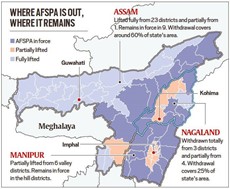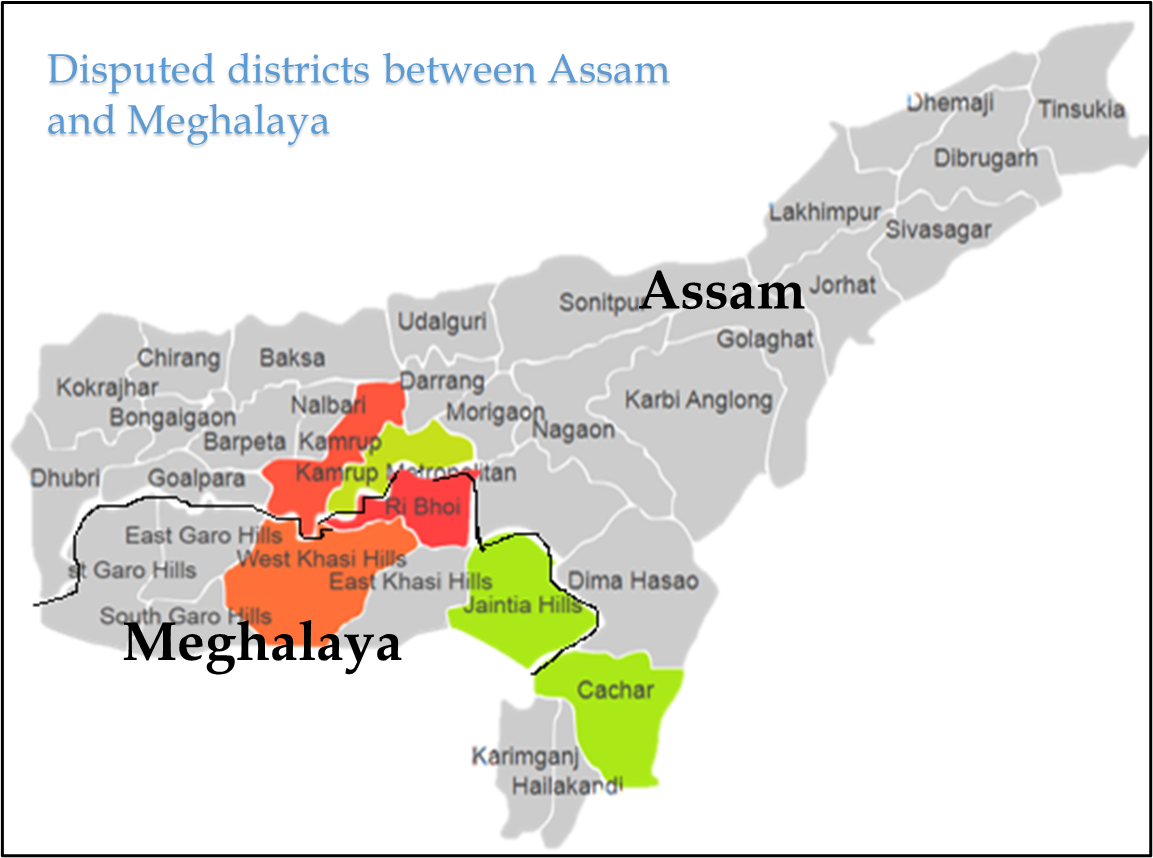Wednesday, 16th March 2022
Municipal Corporation of Delhi (MCD) Unification
In News
The Centre is likely to take up unification of Delhi’s three municipal corporations in the upcoming budget session of Parliament.
The local governance structure in Delhi
- MCD, the second largest civic body in the world after that of Tokyo metropolitan area, was trifurcated in January 2012 into the North, East and South Delhi Municipal Corporations.
- Currently, Delhi has five local bodies, namely the North, East and South Delhi Municipal Corporations, the Delhi Cantonment Board and the New Delhi Municipal Council.
- Growing population and vast geographical spread were cited among the reasons for the trifurcation, which was to lead to decentralisation of administration for better delivery and governance with each commissioner overseeing services for a smaller area.
Financial Stress due to Trifurcation
The employees in the corporation ranging from sanitation workers to doctors and teachers have been on regular strikes every 3-4 months since August 2020 due to delays in payment of their salaries, sometimes for as long as three months.
- Increased expenses of MCD: An increased number of offices employed more officers and committees who had to be remunerated accordingly, raising expenditure in the functioning of the corporations. The financial stress and administrative issues started to become visible three to four years after the trifurcation.
- Unequal distribution of resources and expenses: The trifurcation led to unequal distribution of assets, area, and revenue sources with each municipal corporation generating starkly differing revenue and incurring varied expenses. Thus, the state finances had to be tapped into, in case the expenses were not met.
- g. For instance, post trifurcation, the SDMC got areas that are quite urban and posh, while the NDMC and the EDMC got areas with many slums.
- Moreover, the NDMC got six hospitals, and the SDMC got none, implying that NDMC has a greater number of employees to pay.
- Pandemic Woes: MCD had to incur huge expenses in the pandemic times with an added shortage of revenue generation from toll collection, registry, stamp duty, trade licences, property tax etc. due to reduced movement of people and goods.
Revenue Sources of Municipal Corporations
- Own Tax Revenue: Property tax, vacant land tax, octroi, tax on animals, taxes on carriages and carts, advertisement tax.
- Grants-in-aid: Plan grants made available by way of planned transfers from the state and Central Governments under various projects, programmes, and schemes. Non-plan grants made available to compensate against the loss of income and some specific transfers.
- Borrowings: Loans undertaken by the local authorities for capital works etc., mainly from Life Insurance Corporation of India, State and Central Governments, banks and municipal bonds in select cases. Municipal Corporations require the state governments’ permission to borrow from market sources.
- Assigned (Shared) Revenue: Profession tax, surcharge on stamp duty, entertainment tax, motor vehicles tax
- Own Non-Tax Revenue: Municipal fees, sale and hire charges, user charges, lease amounts
- Other Receipts: Sundry receipts, lapsed deposits, fees, fines and forfeitures, Law charges cost recovered, rent on tools and plants, miscellaneous sales.
Sources:
India’s draft medical devices policy
In News
The Union government has proposed a new policy to reduce India’s dependence on import of high-end medical devices.
About the News
- Aim: The draft medical devices policy 2022 aims to put in place a comprehensive set of measures for ensuring sustained growth and development of the sector and addressing the challenges of the industry.
- It envisages that by 2047, India will be one of the top 5 global manufacturing hubs in terms of value and technology for medical devices.
- It aims to facilitate an orderly growth of the sector lifting local manufacturing and reducing imports to half over the next decade.
- Currently about 80% of the medical devices used in the country particularly high end devices and medical equipment are imported

Key proposals
- The proposal by the Department of Pharmaceuticals under the Ministry of Chemicals and Fertilisers involves:
- incentivising the export of medical devices and related technology projects through tax rebates and refunds,
- increasing government spending in “high-risk” projects in the medical devices sector, and
- a single-window clearance system for licencing medical devices.
- de-carbonising the supply chain, promoting local sourcing, encouraging cross-industry collaboration, establishing a dedicated mechanism for the local industry’s engagements with international regulatory agencies.
- dedicated fund for encouraging joint research involving existing industry players, reputed academic institutions and startups.
- It also involves adopting public-private partnerships to reduce the cost of healthcare, driving efficiency, and aiding quality improvements in medical devices manufactured in the country.
- There is also focus on enabling a pricing environment with no price control on newly developed innovation in the sector.
- The NPPA (National Pharmaceutical Pricing Authority) shall be strengthened with adequate manpower of suitable expertise to provide effective price regulation that will balance patient and industry needs and will incorporate innovation.
- Implementation of a Uniform Code for Medical Device Marketing Practices (UCMDMP).
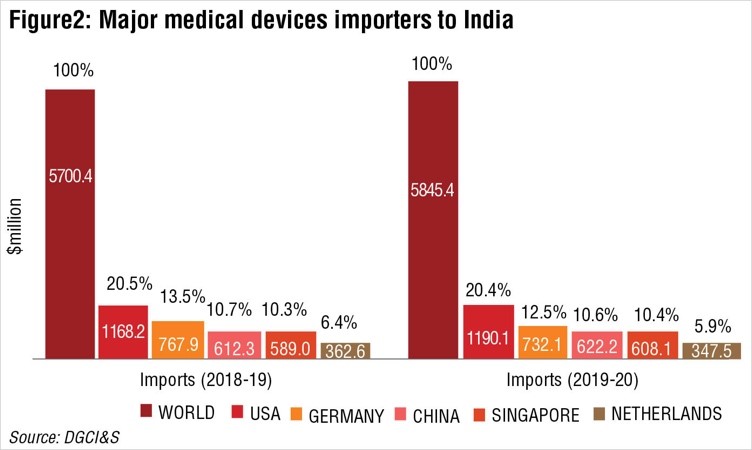
Need for such a policy
- Heavily Import reliant: Nearly 80% of the medical devices currently sold in the country are imported, particularly high-end devices (this will be reduced to 30% in next 10 years under the new policy)
- High value share of foreign companies: Indian players have so far typically focussed on low-cost and low-tech products, like consumables and disposables, leading to a higher value share going to foreign companies.
- No specific policy on medical devices: India’s medical devices sector has so far been regulated as per provisions under the Drugs and Cosmetics Act of 1940, and a specific policy on medical devices has been a long standing demand from the industry.
- Lowest per capita on medical devices: India has one of the lowest per capita spend on medical devices at $3, compared to the global average of per capita consumption of $47, and significantly lower than the per capita consumption of developed nations like the USA at $415 and Germany at $313.
Source:
- Explained: India’s draft medical devices policy, and why it is needed
- Draft Policy to boost domestic production of medical devices out
Image source:
Blockchain gaming
In News
The vast scope and potential of blockchain technology has attracted the gaming industry over the past few years.
About the News
- The popularity and success of blockchain games has been such that it has pushed close to 60% of American and UK-based online game developers to start using blockchain technology.
- Although states such as Sikkim, Nagaland, and Telangana recognize online gaming, in most Indian states and union territories, there is currently a lacuna in laws governing online gaming.
- With blockchain being an online underlying technology, there is no express regulation of it in India and it is pertinent to explore the legality of the games from the lens of existing Indian gaming regulation.
What is blockchain?
Blockchain is a decentralised database that stores information. It relies on technology that allows for the storage of identical copies of this information on multiple computers in a network.
What are blockchain games?
- About: Blockchain games are online video games that are developed integrating blockchain technology into them.
- Types:
- NFT-based: NFTs represent in-game virtual assets that can be owned by players, such as maps, armour or land. These NFTs act as asset tags, identifying ownership of the in-game assets, and are stored on the blockchain.
- Cryptocurrency-based: Tokens based on cryptocurrencies such as the Ethereum blockchain are used for the purchase of in-game assets. These in-game purchases usually enable gamers to buy items like extra lives, coins and so on directly from the game.
- Gaming coins: These are in-game cryptocurrency which may be acquired and then used for the purchase of in-game assets. These may be purchased and traded on crypto exchanges and can be acquired as winnings in games that have adopted the ‘play-to-earn’ model. Example- Axie Infinity (ACS), Enjin Coin (ENJ) etc.,
What are the major issues confronting blockchain gaming?
- Need for IPR protection: The use of blockchain technology for online games is likely to be beneficial for game developers, publishers, and players. However, key to their growth is regulation which ensures that it is permissible to offer such games in the Indian territory and also offers protection in the form of intellectual property rights.
- Securing Privacy: Concerns, such as privacy and cyber security, along with how financial regulations would apply to blockchain games, needs to be addressed and codified with appropriate accommodation for emerging technologies.
- Uniform ASCI guidelines: Government can bring law for uniform Advertising Standards Council of India (“ASCI”) guidelines for advertising of virtual digital assets and linked services.
Sources:
First liquid-fuelled rocket
On March 16, 1926, Robert Goddard successfully launched the first liquid-fuelled rocket. he first-of-its-kind rocket reached an altitude of 41 feet, lasted 2 seconds and averaged about 60 miles per hour. Now known as the father of modern rocketry, Goddard's significant achievements in rocket propulsion have contributed immensely to the scientific exploration of space. Goddard didn't live to see the age of space flight, but his foundation of rocket research became the fundamental principles of rocket propulsion. Goddard was the first scientist who not only realized the potentialities of missiles and space flight but also contributed directly in bringing them to practical realization.

Source:
Corporate Governance in India
In News
The recent NSE Scam has revealed the Abysmal state of Corporate Governance in India.
About the News
- In the NSE case, an ascetic was said to have guided its management with business counsel and regulatory advice.
- Infractions at the NSE—which was accused in 2015 of an alleged split-second early-data edge given to some traders—go beyond the misdeeds of one person and implicate board members who had the fiduciary responsibility of monitoring, fixing, and reporting lapses and violations.
- With a long rope granted to the exchange’s top executives, its board apparently betrayed the trust of shareholders whose interests they had to protect.
- The NSE is expected to act as India’s stock market’s first point of control, a preliminary regulator before the legal oversight exercised by the Securities and Exchange Board of India (SEBI). But, the NSE’s operations and governance offer disturbing evidence of multiple breaches, raising the spectre of a first-stage regulator in need of close supervision.
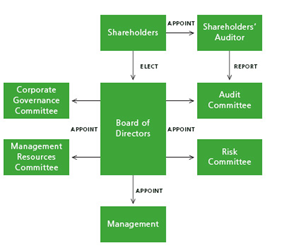
What does Corporate Governance mean?
Corporate governance is the mechanisms, processes, and relations by which corporations are controlled and directed. It stipulates the structures and principles which identify the distribution of rights and responsibilities among different participants in the corporation (such as the board of directors, managers, shareholders, creditors, auditors, regulators, and other stakeholders) and includes the rules and procedures for making decisions in corporate affairs. Simply put it is the code of conduct in business for the good management of the companies.
What are the major issues with Corporate Governance in India?
- Non-adherence to regulations: SEBI had to revise the guideline separation of the chairperson's role from that of the CEO or MD, and disallowing relatives from holding these positions. The low level of compliance has made SEBI change the decision, and separation of the CEO/MD roles has now been made voluntary.
- Challenges in the insider model: A board fails due to lack of diversity of views and unanimous decision making. This is a huge problem in boards where diversity, be it in terms of gender, age, expertise, nationalities, exists as mere tokenism. This is common in India, which is home to family-owned multimillion-dollar businesses.
- Lack of transparency: The role of an independent director in upholding the sanctity and integrity of a board and its direction is crucial. However, they are often unable to perform their duties effectively, including obligations to board members who have recruited them.
- Lack of due compensation: The remuneration of independent directors is often not commensurate with their responsibilities. When compared with benchmarks set by developed countries, like Switzerland, UK and US, the contrast is glaring. This discourages qualified people to take on the role of independent director.
- Non-coverage of unlisted corporates: This is one of the major hindrances caused to effective corporate governance as the applicability of rules and regulations are restricted to the listed entities only as per the clause 49 of the listing agreement.
- Multiplicity of regulations: In India there are many regulatory bodies such as Companies act 2013, Securities and Exchange Board of India (SEBI), Reserve Bank of India, Insurance Regulatory Development Authority, etc. and they have no coordination with each other which leads to multiple provisions for a single type of event/transaction.
- Corporate social responsibility: It is mandatory for companies to allocate a minimum of 2% of the profits in the last 3 years for CSR. The small and the mid-sized firms do not have the resources to allocate separate funds to CSR from its profit.
- Founders' Control and Succession Planning: In India, founders' ability to control the affairs of the company has the potential of derailing the entire corporate governance system. The founders, irrespective of their legal position, continue to exercise significant influence over the key business decisions of companies and fail to acknowledge the need for succession planning.

Regulations related to Corporate Governance in India
- The organizational framework for corporate governance initiatives in India consists of the Ministry of Corporate Affairs (MCA) and the Securities and Exchange Board of India (SEBI).
- SEBI monitors and regulates corporate governance of listed companies in India through Clause 49. This clause is incorporated in the listing agreement of stock exchanges with companies, and it is compulsory for listed companies to comply with its provisions.
- MCA through its various appointed committees and forums facilitates exchange of experiences and ideas amongst corporate leaders, policy makers, regulators, law enforcing agencies and non- government organizations.
- There are many acts with provisions relating to corporate governance in India:
- The Companies Act, 2013: It has provisions regarding the constituency of the board, general meetings, audit committees, board processes etc.
- ICAI (Institute of Chartered Accountants of India): There are various accounting standards related to corporate governance such as disclosure of financial statements set by ICAI.
- ICSI (Institute of Company Secretaries of India): There are various secretarial standards on meeting of the board of directors, general meetings set by ICSI which must be followed by the companies.
- Standard listing agreement of stock: This is regarded as the most important framework for corporate governance which is applicable to the listed companies.
Steps to overcome the challenges of Corporate Governance
- Investment in Compliance cost: Simplifying the unambiguous regulations might promote the smooth functioning of the company and encourage corporate governance as the compliance cost will reduce.
- Changing regulations with time: In this time of rapid growth where the technology changes day by day it is important to upgrade the regulations of corporate governance in accordance with the changing industrial and economic climate of the country.
- Regulations for unlisted companies: The unlisted companies should also be brought under the purview of corporate governance for healthy competition and better competition goals. Standard and incentives are required for the mid-sized new entrants of the capital market.
- Stringent rules for transparency: Providing clear rules on transparency will make compliance of corporate governance easier and effective. Strengthening the disclosure strategy can prove to be the steppingstone to effective corporate governance in India.
- Practices for business, crisis management and sustainability:
- Dynamic Risk Identification, Assessment and Management
- The Board must seek frequent briefing on the company's indebtedness, the bank financing, lines of credit, liquidity risks in short term and work with the management to proactively secure the liquidity needs.
- One of the most successful strategies of risk mitigation is a prompt and measured disclosure.
- Facilitating and undertaking year end audits.
Conclusion: The concept of corporate governance hinges on total transparency, integrity and responsibility of the administration and the board of directors. Be it finance, taxation, banking or legal structure each and every place requires good corporate governance. The Gandhian principle of trusteeship and the Directive Principles of the Indian Constitution has been cited as inspirations for the Indian approach. The corporate governance structure should ensure that the board of directors is effectively supervised and answerable to the company and its shareholders.
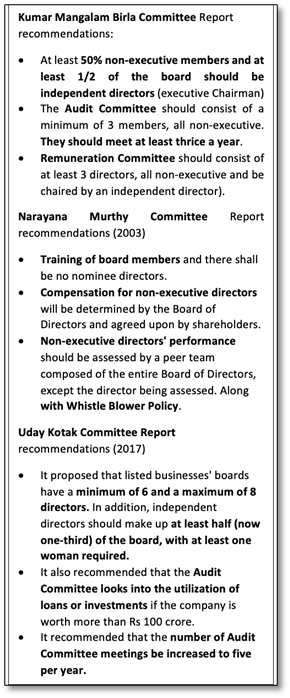
Question: Discuss the various issues related to corporate governance in India.
Sources:
- The recent NSE Scam has revealed the Abysmal state of Corporate Governance in India:
- Corporate governance is a pot on high-heat again:
- Governance 101:
- India: NSE Scam: A Wake Up Call For Corporate Governance:
- Corporate governance breakdown in India’s corporates: Time for an overhaul?:
- Corporate Governance in India: Key challenges and what needs to change:
- Evaluation of existing Legislative Framework of Corporate Governance in India:
- India: Corporate Governance In The Times Of COVID-19:
- Top Ten Issues in Corporate Governance Practices in India:
- Issues and Challenges of Corporate Governance in India:
- Need for Effective Corporate Governance and Its Challenges:
Iron Age memorial
This is image of a relic of the Iron Age called menhir found on the roadside at Ellarigudem, Andhra Pradesh. The menhir belongs to the Iron Age (3,500 years old) erected in memory of a dead person, measuring six feet in height and three feet in diameter. Peculiarity of the ‘menhir’ lies in its white colour. A Menhir is a tall, vertically placed standing stone. They can be found individually as monoliths, or as part of a group of similar stones in circular and linear formations. It is believed that rituals and other ceremonies would have been carried out around them.

Sources:
MANPADS
- Context: The United States and NATO have been shipping weapons into Ukraine including highly sensitive ones such as Man-Portable Air-Defense Systems (MANPADS).
- MANPADS are short-range, lightweight and portable surface-to-air missiles that can be fired by individuals or small groups to destroy aircraft or helicopters.
- They help shield troops from aerial attacks and are most effective in targeting low-flying aircrafts.
- MANPADS can be shoulder-fired, launched from atop a ground-vehicle, fired from a tripod or stand, and from a helicopter or boat.
- It weighs between 10 to 20 kgs and is not longer than 1.8 metres, thus being fairly lighter in weight as compared to other elaborate weapon systems, making them easy to operate by individual soldiers and operating them requires substantially less training.
- The missiles are fitted with Infrared (IR) seekers that identify and target the airborne vehicle through heat radiation being emitted by the latter.

Source:
- 'Risk worth taking': U.S. rushes MANPADS to Ukraine despite proliferation concerns
- Explained | What are MANPADS that the West is sending Ukraine?
Image source:
Booklet “BE(A)WARE”: RBI
- Context: The RBI has recently released a booklet on modus operandi of financial frauds.
- The booklet, BE(A)WARE aims to enhance public awareness about financial frauds perpetrated on gullible customers while carrying out digital payments and other financial transactions.
- The commonly used fraudulent techniques are SIM swaps, vishing/phishing links, lottery, etc., including fake loan websites and digital apps.
- It also mentions the general precautions and the digital hygiene to be taken while carrying out various financial transactions.
- It lays emphasis on the need for always keeping one’s personal information confidential, being mindful of unknown calls / emails / messages, etc.
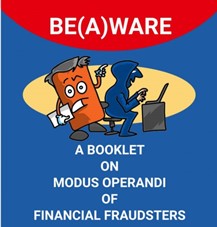
Source:
- RBI releases booklet on modus operandi of financial frauds.
- Modus Operandi and Precautions to be taken against Fraudulent Transactions - Banks
Image source:
Syllipsimopodi bideni
- Context: A fossil belonging to species Syllipsimopodi bideni, recently unearthed in central Montana (US) has been named after the US president, Joe Biden.
- The species represents the oldest-known relative of today's octopuses and boasts 10 arms, with two twice as long as the other eight.
- Syllipsimopodi is derived from the Greek word “syllípsimos” for “prehensile” and “pódi” for “foot”.
- It is the only known vampyropod (soft-bodied cephalopods typically characterized by eight arms and an internalized chitinous shell or fin supports) to retain the ancestral ten-arm condition.
- It is about 12 cm long, with a torpedo-shaped body and squid-like appearance though it was not closely related to squids.
- It is the oldest-known creature with suckers, which enable the arms to better grasp prey and other objects and is noted to be a mid-level predator, eating smaller invertebrates.
- It is believed to have drifted across oceans nearly 328 million years ago.
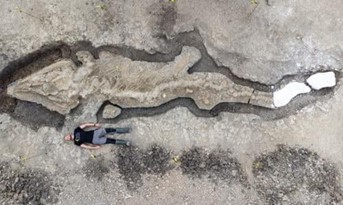
Source:
Image source:
Sawfish
- Context:An enormous sawfish was caught off the coast of Karnataka and illegally sold to a trader recently.
- Sawfish, also known as thecarpenter sharks are among the largest fish species reaching lengths of about 7–7.6 m (23–25 ft).
- They arefound to inhabit the tropical and subtropical regions in coastal marine and brackish estuarine waters as well as freshwater rivers and lakes.
- They are considered avital part of the marine ecosystem as they forage and unearth smaller organisms, making it easier for other animals to find prey.
- Theyfeed on fish and invertebrates that are detected and captured with the use of their saw.
- They are listed as “critically endangered” in the IUCN Red Listand is protected under India's Wildlife Protection Act 1972.
- Under Indian law, people buying or selling sawfish canface fines or imprisonment, the same penalties as for killing a tiger or an elephant.
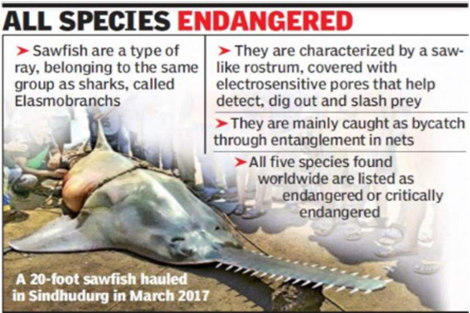
Source:
- Huge, Critically Endangered Sawfish Caught by Fishermen, Sold to Trader
- Critically endangered sawfish caught off Karnataka coast. Watch video
Image source:
A misfiring and its trail of poor strategic stability: TH
Essence: The author uses the context of missile misfiring to assess the bilateral mechanisms for crisis management between India and Pakistan. While the incident had the potential to escalate into a crisis, the response from Pakistan was balanced. There is little bilateral mechanism for crisis management between both the countries. The two sides do not have high commissioners on the other side, have not held Expert Level Talks on Nuclear Confidence Building Measures or Expert Level Talks on Conventional Confidence Building Measures for several years now.
The author recommends including cruise missiles in the Pre-Notification of Flight Testing of Ballistic Missiles agreement, holding meetings on nuclear confidence building measures (CBMs) and conventional CBMs and engaging China in strategic stability discussions as it is today involved in the India-Pakistan conflict more than ever before. The author further recommends setting up mechanisms such as nuclear risk reduction centres (NRRCs), established between the U.S. and the Soviet Union during the Cold War on the lines of permanent Indus Commission. The primary objective of NRRCs is to reduce risk by providing a structured mechanism for timely communication of messages and proper implementation of already agreed upon confidence building measures.
Why should you read this article?
- To know about the response from India and Pakistan to missile misfiring.
- To know about the current status of nuclear forces in both the countries.
- To understand the current bilateral mechanisms for crisis management between both the countries and suggestion for improvement.
Source:
Fixing Indian higher education is the ideal way to rescue students: LM
Essence: Students suffer on educational, economic, mental health, and physical fronts at times like the covid epidemic or the current war scenario in Ukraine. Now we must consider why so many students prefer to pursue their studies abroad. According to various studies, scholarships, on-campus jobs, and work-permit options are among the factors that draw Indian students to study overseas. In this way, we are losing not only financially, but also in a variety of other ways as talented people resources leave the country.
India is targeting gross enrolment ratio (GER) for higher education 50% by 2030 (above 27% at present) for this, we must urgently take the following measures to arrest this drain of wealth and human resources. One, Increase the supply of public and private institutions; two, rationalise the country's current caste-based reservation system & standardise the curriculum across universities; three, begin scholarships and on-campus jobs such as those for research and teaching. The predicament of Indian students in the event of a pandemic or a war has highlighted the need to rethink our higher education system. It's not just a question of a wide difference between supply and demand. A good education can lead to the development of greater human resources, which will be beneficial to the country in the long run.
Why should you read this article?
- To comprehend the problems with India's higher education system and their ramifications.
- To determine the steps we should take to address the problem.
Source:
Is a Washington Beijing Reset Underway: HT
Essence: The editorial talks about the various schools of thought on USA’s perception of China and possible Chinese actions in reference to Russia. While on one hand, there is no ambiguity regarding wreck Russia is viewed as, there are three schools of thought on China- one sees China as economic and technological competitor with whom USA must accommodate, a China that is ambitious but the one that wouldn’t promote war. Next thought perceives China as a long-term adversary but again someone that would not encourage war for its own good. And the third thought assumes Russia-China axis to be far more powerful than what is being perceived.
Chinese response could also be seen in multiple light. One, if China supports Russian annexation, it’d promote a renewed warfare against Europe but would antagonize Chinese interests in the west. Second, the method of engagement towards all stakeholders, speak of sovereignty and also defend Russia’s security interests. Third, be the peacemaker.
In any possibility, Russia isn’t getting away from Chinese partnership, nor is USA befriending China. A reset in USA-China relationship is far away. An adjustment would be the way to proceed, and hence, India must be willing to make similar diplomatic and strategic changes in synchrony with the changing scenario.
Why should you read this article?
- To understand the possibilities of relationship and engagement between USA and China during the Russia-Ukraine crisis.
- To know the value and reasons for Chinese response and context for India’s agility in diplomacy.
Source:
Bahini: A free sanitary napkin initiative
Background
Recently the Sikkim Government launched the Bahini scheme which aims at providing 100 per cent access to free and safe sanitary napkins to school girls of 9-12th standard.
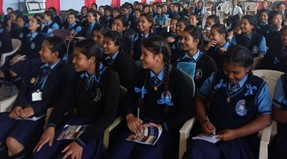
About the initiative
- Menstrual hygiene is often a neglected topic due to various rudimentary
- During a study, it was found that girls tend to skip school 5-6 days of menstrual cycle every month due to lack of availability of pads and washroom in school.
- Menstrual poverty is high in Sikkim, due to which buying sanitary napkin is an expensive affair, forcing girls to use homemade napkins which are not safe.
- Availability of free and hygienic napkins will provide a better lifestyle and health benefits to the girls along with a behavioural change.
- The initiative will be formalised through sanitary napkin vending machines in schools, along with anganwadi workers appointed for making the accessibility better.
Quote: "Don't wait for a girl to become a woman to empower them.
Source:
Share the article
Get Latest Updates on Offers, Event dates, and free Mentorship sessions.

Get in touch with our Expert Academic Counsellors 👋
FAQs
UPSC Daily Current Affairs focuses on learning current events on a daily basis. An aspirant needs to study regular and updated information about current events, news, and relevant topics that are important for UPSC aspirants. It covers national and international affairs, government policies, socio-economic issues, science and technology advancements, and more.
UPSC Daily Current Affairs provides aspirants with a concise and comprehensive overview of the latest happenings and developments across various fields. It helps aspirants stay updated with current affairs and provides them with valuable insights and analysis, which are essential for answering questions in the UPSC examinations. It enhances their knowledge, analytical skills, and ability to connect current affairs with the UPSC syllabus.
UPSC Daily Current Affairs covers a wide range of topics, including politics, economics, science and technology, environment, social issues, governance, international relations, and more. It offers news summaries, in-depth analyses, editorials, opinion pieces, and relevant study materials. It also provides practice questions and quizzes to help aspirants test their understanding of current affairs.
Edukemy's UPSC Daily Current Affairs can be accessed through:
- UPSC Daily Current Affairs can be accessed through Current Affairs tab at the top of the Main Page of Edukemy.
- Edukemy Mobile app: The Daily Current Affairs can also be access through Edukemy Mobile App.
- Social media: Follow Edukemy’s official social media accounts or pages that provide UPSC Daily Current Affairs updates, including Facebook, Twitter, or Telegram channels.


